Golden Eagle
(Aquila chrysaetos)
Mykola Rud'
Translation in Engl.: Yevheniia Mikheenko
The Golden Eagle is a large, energetic and agile bird, reaching up to 85-90 cm and 3-6.5 kg in weight. A commonly used name of Turkic origin, which has entered the Ukrainian language, is berkut, but it is also known among the Asian peoples as khalzan. The Czechs and Slovaks call the bird orel skalni, Poles - orel przedni or birkut and Hungarians - szirtisas; in German it is called steinadler and in Finnish - kotka.
In taxonomy, the bird is a typical eagle. It has long and rather narrow wings and powerful feet with sharp talons. The females are noticeably larger than the males, but have the same dark-brown colouring. The back of the head and neck are reddish. Young birds have a lighter tail with a dark stripe. A characteristic of the species is morphological changeability depending on the region of origin.
The Golden Eagle is widespread in Eurasia (from forest-tundra to Caucasus), in north-western Africa and North America. In Ukraine it is found in the Carpathians and in Belarus’ a pair was noted in the Vitebsk region according to data for 1986. However, in the last decade not a single nesting pair was seen in Mogiliov, Grodno and Minsk regions. The bird has also left the territory of Prypiat’ Nature Reserve. The eagle usually inhabits large forest areas or islands on marshy land. In the Carpathians the birds nest in inaccessible mountain locations. The nests may reach 3m in diameter and 2m in height, and they are used for many years, if not threatened or adversely affected by the surroundings. Each pair of birds may have several spare nests in the boundaries of feeding regions, which they tend to defend, especially when rearing their young.
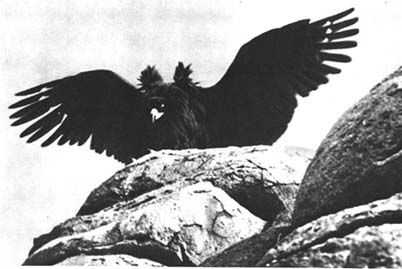
This unique photo
captures a Golden Eagle
defending its nest.
The ruffled feathers
on the back of its neck
denote agression,
showing there is
a real threat of attack.
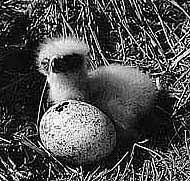
In the nest of a Golden Eagle there are usually one or two cream-coloured eggs, which are laid in April. They hatch after one and a half months, and in the first 30 days the eaglets are covered in fine white down. During the next month they gradually fledge, and are able to fly at the age of 75-80 days, although they stay under the protection of their parents during the whole year until the next breeding season. Golden Eagles are typically monogamous birds. Pairs are formed for life. From a year old to maturity the young birds actively migrate, but mature pairs are settled, due to the fact that in the wild the eagles prey on large mammals such as wild goats and piglets, as well as hares. The bird can take steppe marmots and ground squirrels on the ground from flight, or trap them near their holes. The Golden Eagle also hunts feathered prey such as wood grouse, black grouse, or, less often, various water-fowl.
Although the birds are capable of tackling a wide range prey, as a rule they keep to their traditional territory, which is a hunting ground that is able to sustain the adult pair and to feed the young.
The Golden Eagle is a protected species around the world. In Ukraine it needs special attention. According to written records, in 1985 fifty birds of various age and sex were kept in the zoos of the former USSR. In that year the first attempt to breed the eagle in captivity was made, and at the end of March two eggs were laid, 130g and 136.9g. After artificial incubation for 41 and 42 days, two eaglets hatched weighing 76.8g and 83.4g. The pair of eagles whose eggs were taken for incubation soon laid another two eggs. From them, after incubation by the female, one eaglet hatched. It was bred independently by the eagle pair.
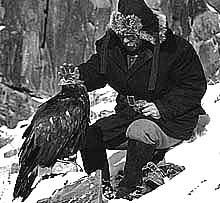
The Berkutchi is a falconer who hunts with the Golden Eagle.
As a rule he is a respected person, capable of training and
using the bird correctly.
The Synchy (in Turkic or Kirghiz language) is a qualified
connoisseur of the natural and hunting qualities of the
Golden Eagle, and of everything concerning the process
of training and hunting with the bird.
Traditionally, the rulers of lands on which nesting territories were located were seen as the owners of the birds. In the majority of cultural traditions where ownership of land was defended by the law, hunting the adult birds or taking eaglets from the nests was strictly forbidden without leave of the owner.
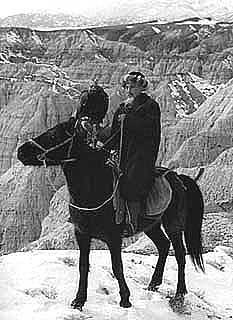
Taking into account the existing falconry traditions and magic superstitions which survive to this day, the selling of a Golden Eagle is a very rare or almost impossible event. Therefore, the appearance of a self-styled berkutchi was out of question.
Among the Asian peoples, learning to train birds of prey started from childhood. The first attempts and hunting amusements were made with the Sparrow hawk or Hobby, and later the young hunters tested their skill with the Goshawk, Saker, Peregrine and Gyrfalcon. The last bird trained, considered the most significant and capable of taking the greatest range of game, as well as the most dangerous, was the Golden Eagle. The training of this bird was seen as difficult and even perilous even by the experienced Synchy.
The young who attempted this were carefully supervised and assisted by older, experienced falconers who passed on the necessary knowledge and skills. The training of a Golden Eagle could only be started by those who mastered all falconry skills under supervision and tuition of an experienced relative. This was not only logical but necessary considering the danger presented by the large and powerful bird.
The process of training a Golden Eagle is long and complex. Much effort must be devoted to the training of an able hunter. Berkutchi-falconers, being mostly people of middle or older age, always subtly and precisely noted the morphological and other characteristics that allowed them to recognise in the bird a quality hunter.
As noted by R. Pfeffer in his well-known work ‘The Bird on the Hand’ (‘Ptitsa na ruke’), the secrets of taming a Golden Eagle were passed from generation to generation down dynasties. From father to son, or sometimes to grandson, were handed and explained in detail the secret characteristics by which a falconer was able to make the right choice when taking a bird for training. This was a very important step, as there were cases when the fruitful collaboration and friendship between the bird and the man lasted for over thirty years.
In the Eastern school of training there are two ways to get a well-trained, obedient and able bird: the first is to find a nest, reaching it in the favourable time according to classical canons kept secret by every dynasty, and to choose an eaglet. Afterwards it is necessary to rear the bird to mature age, simultaneously teaching it hunting techniques.
The other way is to catch an adult eagle, already capable of hunting on its own. Here it is also important to make the right choice and catch the best and most agile of the birds. For this a berkutchi observes young eagles for a long period in the wild, and only later decides which must be caught. This is done in the late autumn. Having established the boundaries of the chosen bird’s feeding grounds, nets and bait such as pigeons or partridge are set. If organised well, the hunting lasts only a few days. There is also another way to catch a Golden Eagle, described by V. Alzhanov and used in the Kazakhstan steppes. A hunting eagle is observed at a long distance, and after it feeds on its prey the bird is chased on a good steed. Rising with a heavy crop to a height of up to 100m, the bird is able to fly 4-5km using the warm air currents yet soon it is forced to come down and alight. Pursued by a mounted hunter, the eagle needs a significant effort to take off again, but now it keeps at a height of 40-50m, unable to rise higher and effectively use the higher currents. However, even maintaining this height is beyond the bird’s strength, and it is forced to search for a place to come down for a rest. As soon as this happens, the hunter starts to overtake it. It is rather difficult for the eagle to fly up for the third time with a heavy load of meat in its crop, and as a rule it is unable to reach a height above 20m. In this state of exhaustion the bird can fly up to a kilometre, but then is forced to alight again if there are no trees or hills nearby. Defending itself against the man, the eagle lies on its back, stretching forward the formidable talons. An experienced hunter lashes at it with a piece of soft felt, which the eagle instinctively clutches. The bird is then quickly covered with a soft fabric, to swaddle it and prevent traumas.
After this, the bird’s crop is emptied of meat and washed with tea or sugar solution, so preparation for training can begin immediately. The aim of the following training process is to stop the bird shunning its owner. For this the eagle is not given food or sleep for a couple of days. According to the Eastern school of training, during this time the berkutchi must not sleep either. He must be near the bird, talking to it, singing to it or playing the domra. As a result of prolonged communication the eagle tires, accustoms to its situation and takes food from its owner’s hands. In this way the eagle accepts the man’s friendship, but never acknowledges itself defeated. From that day forth, the bird is never a slave of its owner, but only a partner in hunting. A long period of training follows, as the bird masters new techniques and methods of hunting.
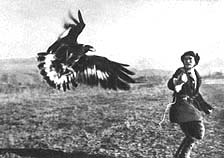
The character of a Golden Eagle caught when adult differs significantly from that of a bird bred in captivity. The former orientates brilliantly when hunting, pursuing only the game of value for the falconer. Such intelligent behaviour is largely due to the eagle’s independent hunting practice. As opposed to those reared in the wild, the eagles taken from the nest when young and bread by people tend to attack anything, including domestic animals or, most alarmingly, children. Such eagles in Kazakhstan receive the name “kor-bala”, literally meaning “a blind child”. They are only hunted with in the open steppe, at a distance from human settlements. Another negative trait of “kor-bala” is its loud cries when hunting. This often spoils a hunt, as the prey, hearing the characteristic tone of the eagle, either hide or run from the hunting ground. Also, the birds are much weaker physically compared to the wild specimens caught mature.
When trained by a falconer, the Golden Eagle no longer needs to hunt the prey it previously fed on. Its main game now is usually the fox, and a trained eagle soon masters the art of brilliant victory over it. In one day, a berkutchi may gain four or five foxes.
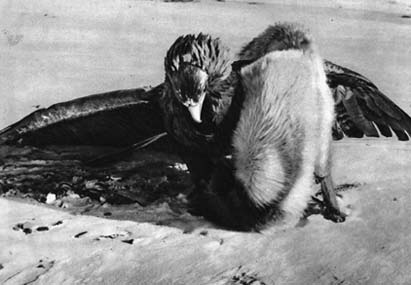
With an eagle called by the
Kazakhs “altaidyn-ok-ingy”,
as noted by many authors, the
catch can be twice as great.
Considerably less hunted is the corsac (Vulpes corsac) and tolai-hare (Lepus tolai). Until recently, the industries of Kazakhstan received a large number of cured fox-pelts from experienced berkutchi-falconers. Hunting during the cold season or in mountainous areas, the bird loses much strength in pursuit and combat with the prey. Taking into account that, to maintain the required fitness level and prevent putting on extra weight, the food of the bird does not always completely satisfy the requirements of the bird’s metabolism, experienced falconers take great care to save the eagle from exhaustion. For this, after hunting the bird is carefully wrapped in soft wool and placed in a special carrier frame, called “boleu” in Kazakhstan. In this way the eagle is warmed quickly and does not spend its energy keeping balance on the owner’s hand on the way back.
Numerous poetic reminiscences in modern times about the bringing down of wolves by the Golden Eagle are probably significantly exaggerated. In the cases when this did happen, we are talking about wolflings that would not be able to defend themselves against the powerful bird. Most hunters do not risk casting a mature eagle at an adult wolf, which can cripple in combat even a highly experienced bird of prey. It must be noted that if the bird loses even one finger or talon, this will significantly lower its ability to tackle prey and thus its effectiveness in fighting a strong animal such as a fox. Only a minor injury to the sinew of a foot may leave the eagle incapable of further hunting. In the cases when the bird is still able to catch minor prey for food with its healthy foot, such as rodents, reptiles or small birds, the eagle is released into the wild.
And still, the hunting of wolves with the Golden Eagle was a reality in the past. Some berkutchi dynasties, to order of the Kazakh families that migrated to the North in winter for hunting and needed warm clothes, trained their birds and organised wolf-hunts. This was because the wolf-pelts provided material for clothes crucial for survival in the severe colds. Therefore, appropriate methods were devised. Aiming for the wolf-pelts, the falconers used special methods from the very beginning of a bird’s training, targeted exclusively to prepare it for casting at wolves. The bird was specially trained to attack a stuffed wolf. It had to take the animal, as the hunters said, “at the place” - i.e. with one foot at the back of the neck and another at the flank closer to the heart and lungs. Then the bird must quickly peck out the wolf’s eyes with its powerful beak. This method required the application of certain family secrets of training, as was important to train the eagle to use a complex and at the same time instantaneous method of depriving the beast of it's orientation and capability of self-defence. With this aim, during the long training sessions the bird was taught to fly at a stuffed wolf and peck out tasty morsels of meat placed into the skull cavity instead of the eyes. In this way, the subtlety of hunter’s thought achieved the desired result. As the wolf, being a strong, formidable beast, is capable of resisting even the best-trained bird, the falconer always keeps near, ready at the first opportunity to help the eagle. However this should be done carefully, as the wolf, sensing human presence, fights desperately to tear loose from the bird’s talons, and the eagle can be severely injured. Indeed, the wolf-trained Golden Eagles have a shorter life span. Now, when wolf-pelts are no longer a vital necessity, the stories about eagles hunting wolves are more often a hunter’s exaggeration or a beautiful legend.
According to M. Alzhanov, Kazakh falconers tell the age of Golden Eagles by the colour of their tail. A year-old eagle is called “balapan”, two-year-old - “tyrnek”, three-year-old - “tastulak”, four-year-old - “ama’ and five-year-old - “kana”. Also distinguished are age groups “barshyn”, which means a mature bird, which has gained its final colouring, and “koktulek” - a very old eagle. The latter differs from a “barshyn” by the grey colour of its down, which is white in younger birds.
In captivity the Golden Eagle hunts effectively during five or maximum ten years, after which the birds usually die of diseases. Such a short period of keeping hunter eagles is probably due to the poor standards of maintenance, feeding and use of the birds in hunting.
Cases of amateur keeping and hunting with the Golden Eagle were noted in Kyiv in the 80s. However, this did not become widespread because the catching or taking from the nest a specimen entered in the “Red Book” of many countries, and also the register of the World Wide Fund for Nature, is illegal (CITES). The classic method of hunting with a Golden Eagle is on horseback with a hound.
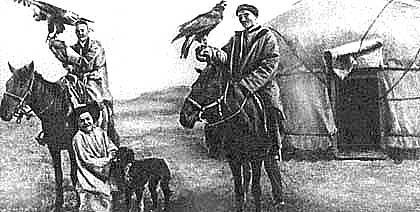
From ancient times, berkutchi-falconers
in the nomadic herder societies had the
role of preserving and stocking furs.
They and their families held the secrets
of curing hides and pelts, and also
of making clothes from them.
The high social status of the berkutchi and his family was conditioned by the climate, as warm, strong and durable clothing for the people during the winter seasons was a vital necessity. Best-suited for this were the pelts of wolves and foxes. In this way, the berkutchi clan was a unique treasury of family or dynastic lore shrouded by mystery.
In the recent past, and even now in Middle Asia, a horseback rider with a Golden Eagle on the hand is perceived by the people as more than a hunter. Often, a berkutchi is of noble birth, and in the imagination of the people is a person of a higher spiritual level.
Apart from hunting, berkutchi can give spiritual support to pregnant women, who experience or may experience difficulties in childbirth. Through the owner of the bird, which in the imagination of Asian peoples is a symbol of well-being and power, or sometimes even through a whip sent by him, blessing and support can come from above on a woman giving birth. According to folk wisdom, a berkutchi is the indisputable authority in the sphere of childbirth or of renewing fertility. In the cultures of many nomadic and semi-nomadic peoples of Asia, it is said that a berkutchi, regardless of age, can make pregnant a woman who for a long time had not had children.
Unfortunately, in the last two hundred years up to the end of the 20th century, the region of Middle Asia was marked by social and ecological degradation due to being part of Muscovy and later of the USSR, which carried profound impacts. The unique culture of hunting with birds of prey and the best folk traditions were seen as old-fashioned and were thus persecuted.
The destruction of natural environment, contamination of soils and sources of water reached such colossal scale that they affected not only the spiritual sphere but the genotype of indigenous peoples in Asia.
Through centuries, the berkutchi was a person with a high social status, which is now, unfortunately, almost lost. There is hope that the achievement of independence by many Asian peoples will lead to a rebirth of their unique cultures and traditions.
*****************************************************
The pictures from magazines "Didar", ôÅÈÎÉËÁ ÍÏÌÏÄÅÖÉ";
©
Ukrainian magazine "Naturalist"